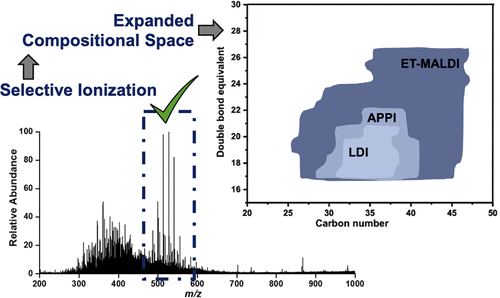当前位置:
X-MOL 学术
›
Energy Fuels
›
论文详情
Our official English website, www.x-mol.net, welcomes your feedback! (Note: you will need to create a separate account there.)
Effect of the Ionization Source on the Targeted Analysis of Nickel and Vanadyl Porphyrins in Crude Oil
Energy & Fuels ( IF 5.3 ) Pub Date : 2021-08-31 , DOI: 10.1021/acs.energyfuels.1c01743 Juan S. Ramírez-Pradilla 1 , Cristian Blanco-Tirado 1 , Marie Hubert-Roux 2, 3 , Pierre Giusti 3, 4 , Carlos Afonso 2, 3 , Marianny Y. Combariza 1
Energy & Fuels ( IF 5.3 ) Pub Date : 2021-08-31 , DOI: 10.1021/acs.energyfuels.1c01743 Juan S. Ramírez-Pradilla 1 , Cristian Blanco-Tirado 1 , Marie Hubert-Roux 2, 3 , Pierre Giusti 3, 4 , Carlos Afonso 2, 3 , Marianny Y. Combariza 1
Affiliation

|
We compare the performance of atmospheric pressure photoionization (APPI), laser desorption ionization (LDI), and electron-transfer matrix-assisted laser desorption ionization (ET-MALDI) for the analysis of petroporphyrin (PP)-enriched extracts. APPI, one of the most used ionization sources for crude oil analysis because of its low matrix and ion suppression effects, provides a broad picture of the crude oil extract, including PPs. APPI analysis resulted in a complex spectrum with more than 12000 radical cations where signals from high ionization energy (IE) species with abundant heteroatoms (NxOySz) predominate, masking the PP target group. LDI shows species with aromatic cores or conjugated functionalities particularly susceptible to UV laser excitation and ionization. A reduction in N-containing compounds (NxOy, NxSz) and an increase in PPs signals indicate some selectivity in LDI. ET-MALDI resulted in a less complex spectrum with 3500 radical cations mainly from aromatic species, including NiPP and VOPPs. PPs’ selective ionization in ET-MALDI occurs via thermodynamically favored charge exchange reactions between the matrix radical cations and the analytes. ET-MALDI results in fewer ions per nominal mass than APPI and LDI, a situation benefiting signal resolution and mass accuracy in FT-ICR-MS. Identifying more than 350 PPs in crude oils (N4VO, N4VO2, N4VO3, N4VOS, and N4Ni) was possible by combining isotopic structure analysis and data refinement using the Kendrick mass defect (KMD) plots. The PP compositional space in ET-MALDI includes 269 species corresponding to N4VO and N4Ni classes, in contrast with 65 in APPI and 53 LDI. The compound classes N4VOS, N4VO2, and N4VO3 were not observed in APPI or LDI.
中文翻译:

电离源对原油中镍和氧钒卟啉靶向分析的影响
我们比较了大气压光电离 (APPI)、激光解吸电离 (LDI) 和电子转移基质辅助激光解吸电离 (ET-MALDI) 在分析富含岩卟啉 (PP) 的提取物时的性能。APPI 是原油分析中最常用的电离源之一,因为它具有低基质和离子抑制效应,可提供包括 PP 在内的原油提取物的广泛图像。APPI 分析产生了超过 12000 个自由基阳离子的复杂光谱,其中来自高电离能 (IE) 物种的信号具有丰富的杂原子 (N x O y S z) 占主导地位,掩盖了 PP 目标群体。LDI 显示具有芳香核或共轭官能团的物质对紫外激光激发和电离特别敏感。含氮化合物的减少 (N x O y , N x S z) 和 PPs 信号的增加表明 LDI 具有一定的选择性。ET-MALDI 产生了一个不太复杂的光谱,有 3500 个自由基阳离子,主要来自芳香族物质,包括 NiPP 和 VOPP。PP 在 ET-MALDI 中的选择性电离是通过基质自由基阳离子和分析物之间的热力学有利的电荷交换反应发生的。与 APPI 和 LDI 相比,ET-MALDI 每标称质量产生的离子更少,这种情况有利于 FT-ICR-MS 中的信号分辨率和质量精度。鉴定原油中的 350 多种 PP(N 4 VO、N 4 VO 2、N 4 VO 3、N 4 VOS 和 N 4Ni) 可以通过结合使用 Kendrick 质量缺陷 (KMD) 图的同位素结构分析和数据细化来实现。ET-MALDI 中的 PP 组成空间包括 269 种对应于 N 4 VO 和 N 4 Ni 类别的物种,而 APPI 中的 65 种和 LDI 中的 53 种。在 APPI 或 LDI 中未观察到化合物类别 N 4 VOS、N 4 VO 2和 N 4 VO 3。
更新日期:2021-09-16
中文翻译:

电离源对原油中镍和氧钒卟啉靶向分析的影响
我们比较了大气压光电离 (APPI)、激光解吸电离 (LDI) 和电子转移基质辅助激光解吸电离 (ET-MALDI) 在分析富含岩卟啉 (PP) 的提取物时的性能。APPI 是原油分析中最常用的电离源之一,因为它具有低基质和离子抑制效应,可提供包括 PP 在内的原油提取物的广泛图像。APPI 分析产生了超过 12000 个自由基阳离子的复杂光谱,其中来自高电离能 (IE) 物种的信号具有丰富的杂原子 (N x O y S z) 占主导地位,掩盖了 PP 目标群体。LDI 显示具有芳香核或共轭官能团的物质对紫外激光激发和电离特别敏感。含氮化合物的减少 (N x O y , N x S z) 和 PPs 信号的增加表明 LDI 具有一定的选择性。ET-MALDI 产生了一个不太复杂的光谱,有 3500 个自由基阳离子,主要来自芳香族物质,包括 NiPP 和 VOPP。PP 在 ET-MALDI 中的选择性电离是通过基质自由基阳离子和分析物之间的热力学有利的电荷交换反应发生的。与 APPI 和 LDI 相比,ET-MALDI 每标称质量产生的离子更少,这种情况有利于 FT-ICR-MS 中的信号分辨率和质量精度。鉴定原油中的 350 多种 PP(N 4 VO、N 4 VO 2、N 4 VO 3、N 4 VOS 和 N 4Ni) 可以通过结合使用 Kendrick 质量缺陷 (KMD) 图的同位素结构分析和数据细化来实现。ET-MALDI 中的 PP 组成空间包括 269 种对应于 N 4 VO 和 N 4 Ni 类别的物种,而 APPI 中的 65 种和 LDI 中的 53 种。在 APPI 或 LDI 中未观察到化合物类别 N 4 VOS、N 4 VO 2和 N 4 VO 3。


























 京公网安备 11010802027423号
京公网安备 11010802027423号